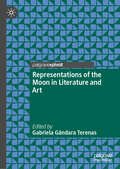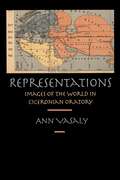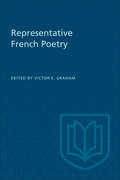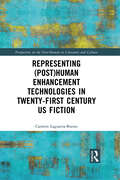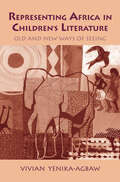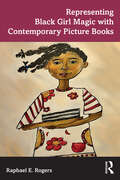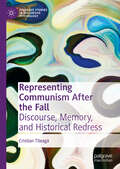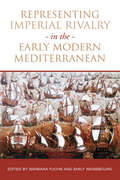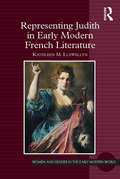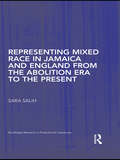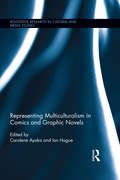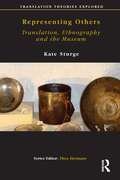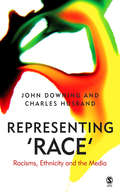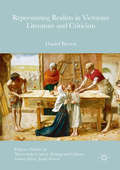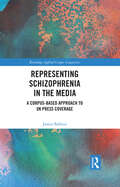- Table View
- List View
Representations of the Moon in Literature and Art
by Gabriela Gândara TerenasThis book brings together a collection of essays on the occasion of the fiftieth anniversary of the arrival of the first man on the moon – a time when tourist journeys to the moon, now a real possibility, were no more than a fantasy. Divided into four sections, illustrating different perceptions of the moon, the common aim of the essays in this book is to examine how mankind’s interest in the moon has been represented in Literature and the Arts, an objective underpinned by the desire to exploit the relationship between the so-called two cultures—the Humanities and Science—as C.P. Snow perceived them in his pioneering work (1959). The plethora of ways in which our companion satellite has been portrayed has led the authors of the essays to draw upon research from the history of science as well as from literary, cultural and artistic studies. In addition to analysing the impact on literature and music, of our arrival on the moon, whether real or imaginary, these studies also examine how writers along the centuries have appropriated the moon as a metaphor in order to project latent conflict, criticise the society or politics of their day, reflect upon scientific or technological discoveries or fantasise about journeys, encounters or imaginary realities.
Representations: Images of the World in Ciceronian Oratory
by Ann VasalyAnn Vasaly introduces representation theory into the study of Ciceronian persuasion and contends that an understanding of milieu—social, political, topographical—is crucial to understanding Ciceronian oratory. As a genre uniquely dependent on an immediate interaction between author and audience, ancient oratory becomes performance art.Vasaly investigates the way Cicero represented the contemporary physical world—places, topography, and monuments, both those seen and those merely mentioned—to his listeners and demonstrates how he used these representations to persuade. Her exceptionally well-written study deftly recaptures the immediacy of Cicero's oratory and makes a trenchant contribution to an important new area of inquiry in Classical Studies.
Representative French Poetry (Second Edition)
by Victor E GrahamThe making of a reasonably comprehensive anthology which is intended to do more than reflect the personal literary tastes of the anthologists is not an easy task, but is certainly an exciting and challenging one. It is important, of course, if it is to have coherence and validity, that its audience be reasonably well defined and kept in mind as the selection proceeds. The anthology offered by Professor Graham has been prepared carefully to meet the needs of students reading French poetry while in the early years of their university course. It does not attempt to be a bulky sample of the whole field of French poetry but rather to be a judicious selection of the works of poets who may be described as typical of the best in their age. From each of them have been included some well-known selections which students must always meet and also some less well known which are nevertheless equal in quality and whose relative unfamiliarity may give them a special appeal to instructors. A particularly interesting and valuable feature of the anthology is that the editor has in a good many cases chosen poems on similar themes from different authors, and students will thus be able to compare styles of different centuries and different poets as applied to certain specific subjects. (For example, the selection includes Deschamps' "Balade" on "Renart et le Corbaut" and La Fontaine's "Le Corbeau et le Renard'; Lamartine's and also Leconte de Lisle's "Le Lac.")
Representing (Perspectives on the Non-Human in Literature and Culture)
by Carmen Laguarta-BuenoThis work studies three twenty-first century novels by Richard Powers, Dave Eggers and Don DeLillo as representative of a new trend of US fiction concerned with the topic of the technological augmentation of the human condition. The different chapters provide, from the double perspective of the optimistic transhumanist philosophy and the more balanced approach of critical posthumanism, an overview of the narrative strategies used by the writers to explore the possibilities that biotechnology, digital technologies and cryonics open up to transcend our human limitations, while also warning their readers of their most nefarious consequences. Ultimately, the book puts forward the claim that even if the writers approach the subject from a variety of perspectives and using different narrative styles and techniques, they all share a critical posthumanist fear that an unrestrained and unquestioned use of technology for enhancement purposes may bring about disembodiment and dehumanization.
Representing (Perspectives on the Non-Human in Literature and Culture)
by Carmen Laguarta-BuenoThis work studies three twenty-first century novels by Richard Powers, Dave Eggers and Don DeLillo as representative of a new trend of US fiction concerned with the topic of the technological augmentation of the human condition. The different chapters provide, from the double perspective of the optimistic transhumanist philosophy and the more balanced approach of critical posthumanism, an overview of the narrative strategies used by the writers to explore the possibilities that biotechnology, digital technologies and cryonics open up to transcend our human limitations, while also warning their readers of their most nefarious consequences. Ultimately, the book puts forward the claim that even if the writers approach the subject from a variety of perspectives and using different narrative styles and techniques, they all share a critical posthumanist fear that an unrestrained and unquestioned use of technology for enhancement purposes may bring about disembodiment and dehumanization.
Representing Africa in Children's Literature: Old and New Ways of Seeing (Children's Literature and Culture)
by Vivian Yenika-AgbawRepresenting Africa in Children’s Literature explores how African and Western authors portray youth in contemporary African societies, critically examining the dominant images of Africa and Africans in books published between 1960 and 2005. The book focuses on contemporary children’s and young adult literature set in Africa, examining issues regarding colonialism, the politics of representation, and the challenges posed to both "insiders" and "outsiders" writing about Africa for children.
Representing Black Girl Magic with Contemporary Picture Books
by Raphael E. RogersRepresenting Black Girl Magic with Contemporary Picture Books explores how contemporary, culturally relevant, and responsive picture books can provide educators with a chance to teach about race and racism in the classroom. A wave of recently published picture books by Black women authors have pushed back against negative beliefs, countered negative stereotypes, and celebrated the joy and magic of Black girls and their families. Featuring the voices and perspectives of over two dozen Black women writers, in this book, Raphael Rogers examines how and why these publications are changing the picture book and the educational landscape.With sections on classroom connections and discussion questions in every chapter, this book is ideal for courses on teaching children’s literature and diversity in children’s literature.
Representing Black Men
by Marcellus Blount George P. CunninghamRepresenting Black Men focuses on gender, race and representation in the literary and cultural work of black men.
Representing Childhood and Atrocity: Representing Childhood And Atrocity
by Victoria Nesfield; Philip SmithAtrocity presents a problem to the writer of children's literature. To represent events of such terrible magnitude and impersonal will as the Holocaust, the transatlantic slave trade, or the Rwandan genocide such that they fit into a three-act structure with a comprehensible moral and a happy ending is to do a disservice to the victims. Yet to confront children with the fact of widescale violence without resolution is to confront them with realities that may be emotionally disturbing and even damaging. Despite these challenges, however, there exists a considerable body of work for and about children that addresses atrocity. To examine the ways in which writers and artists have attempted to address children's experience of atrocity, this collection brings together original essays by an international group of scholars working in the fields of child studies, children's literature, comics studies, education, English literature, and Holocaust, genocide, and memory studies. It covers a broad geographical range and includes works by established authors and emerging voices.
Representing Children in Chinese and U.S. Children's Literature (Studies in Childhood, 1700 to the Present)
by Rebecca Morris Claudia NelsonBringing together children’s literature scholars from China and the United States, this collection provides an introduction to the scope and goals of a field characterized by active but also distinctive scholarship in two countries with very different rhetorical traditions. The volume’s five sections highlight the differences between and overlapping concerns of Chinese and American scholars, as they examine children’s literature with respect to cultural metaphors and motifs, historical movements, authorship, didacticism, important themes, and the current status of and future directions for literature and criticism. Wide-ranging and admirably ambitious in its encouragement of communication between scholars from two major nations, Representing Children in Chinese and U.S. Children’s Literature serves as a model for examining how and why children’s literature, more than many literary forms, circulates internationally.
Representing Communism After the Fall: Discourse, Memory, and Historical Redress (Palgrave Studies in Discursive Psychology)
by Cristian TileagăThis book explores the contribution of discursive psychology and discourse analysis to researching the relationship between history and collective memory. Analysing significant manifestations of the moral vocabulary of the Romanian transition from communism to democracy, the author demonstrates how discursive psychology can be used to understand some of the enduring and persistent dilemmas around the legacy of communism. This book argues that an understanding of language as an action-oriented, world-building resource can fill an important gap in the theorizing of public controversies over individual and collective meaning of the recent (communist) past. The author posits that discursive social psychology can serve as an intellectual and empirical bridge that can overcome several of the difficulties faced by researchers working in transitional justice studies and cognate fields. This reflective book will appeal to students and scholars of transitional justice, discursive psychology, memory studies, and the sociology of change.
Representing Death in the News
by Folker HanuschThis new study maps and synthesizes existing research on the ways in which journalism deals with death. Folker Hanusch provides a historical overview of death in the news, looks at the conditions of production, content and reception, and also analyzes emerging trends in the representation of death online.
Representing Female Artistic Labour, 1848–1890: Refining Work for the Middle-Class Woman
by Patricia ZakreskiPatricia Zakreski's interdisciplinary study draws on fiction, prose, painting, and the periodical press to expand and redefine our understanding of women's relationship to paid work during the Victorian period. While the idea of 'separate spheres' has largely gone uncontested by feminist critics studying female labour during the nineteenth century, Zakreski challenges this distinction by showing that the divisions between public and private were, in fact, surprisingly flexible, with homes described as workplaces and workplaces as homes. By combining art with forms of industrial or mass production in representations of the respectable woman worker, writers projected a form of paid creative work that was not violated or profaned by the public world of the market in which it was traded. Looking specifically at sewing, art, writing, and acting, Zakreski shows how these professions increasingly came to be defined as 'artistic' and thus as suitable professions for middle-class women, and argues that the supposedly degrading activity of paid work could be transformed into a refining experience for women. Rather than consigning working women to the margins of patriarchal culture, then, her study shows how representations of creative women, by authors such as Elizabeth Barrett Browning, Dinah Craik, Charles Dickens, Anthony Trollope, and Charlotte Yonge, participated in and shaped new forms of mainstream culture.
Representing Imperial Rivalry in the Early Modern Mediterranean
by Barbara Fuchs Emily WeissbourdRepresenting Imperial Rivalry in the Early Modern Mediterranean explores representations of national, racial, and religious identities within a region dominated by the clash of empires. Bringing together studies of English, Spanish, Italian, and Ottoman literature and cultural artifacts, the volume moves from the broadest issues of representation in the Mediterranean to a case study - early modern England - where the "Mediterranean turn" has radically changed the field.The essays in this wide-ranging literary and cultural study examine the rhetoric which surrounds imperial competition in this era, ranging from poems commemorating the battle of Lepanto to elaborately adorned maps of contested frontiers. They will be of interest to scholars in fields such as history, comparative literary studies, and religious studies.
Representing Judith in Early Modern French Literature (Women And Gender In The Early Modern World Ser.)
by Kathleen M. LlewellynAlthough attention to the Book of Judith and its heroine has grown in recent years, this is the first full-length study to focus on adaptations of the Bible’s Old Testament Book of Judith across a range of literary genres written in French during the early modern era. Author Kathleen Llewellyn bases her analysis on references to Judith in a number of early modern sermons as well as the ’Judith’ texts of four early modern writers. The texts include two theatrical dramas, Le Mystère de Judith et Holofernés (c. 1500), believed to have been written by Jean Molinet, and Le Miroir des vefves: Tragédie sacrée d'Holoferne & Judith by Pierre Heyns (1596), as well as two epic poems, La Judit (1574) by Guillaume de Salluste Du Bartas, and Gabrielle de Coignard’s Imitation de la victoire de Judich (1594). Llewellyn’s goal is to see Judith as she was envisioned by early modern French writers and their readers, and to understand how the sixteenth century shaped their view of the heroine. Noting aspects of that story that were emphasized by sixteenth-century authors, as well as elements that those writers altered to suit their purposes, she also examines the ways in which writers of this era made use of Judith’s story as a means to explore interests and concerns of early modern writers, readers, and spectators. Representing Judith in Early Modern French Literature provides a deeper understanding of early modern ideas regarding the role of women, the use of exemplary stories in preaching and teaching, theories of vision, and the importance of community in Renaissance France.
Representing Mixed Race in Jamaica and England from the Abolition Era to the Present
by S. SalihThis study considers cultural representations of "brown" people in Jamaica and England alongside the determinations of race by statute from the Abolition era onwards. Through close readings of contemporary fictions and "histories," Salih probes the extent to which colonial ideologies may have been underpinned by what might be called subject-constituting statutes, along with the potential for force and violence which necessarily undergird the law. The author explores the role legal and non-legal discourse plays in disciplining the brown body in pre- and post-Abolition colonial contexts, as well as how are other bodies and identities – e.g. black, white are discursively disciplined. Salih examines whether or not it’s possible to say that non-legal texts such as prose fictions are engaged in this kind of discursive disciplining, and more broadly, looks at what contemporary formulations of "mixed" identity owe to these legal or non-legal discursive formations. This study demonstrates the striking connections between historical and contemporary discourses of race and brownness and argues for a shift in the ways we think about, represent and discuss "mixed race" people.
Representing Multiculturalism in Comics and Graphic Novels (Routledge Research in Cultural and Media Studies)
by Carolene Ayaka and Ian HagueMulticulturalism, and its representation, has long presented challenges for the medium of comics. This book presents a wide ranging survey of the ways in which comics have dealt with the diversity of creators and characters and the (lack of) visibility for characters who don’t conform to particular cultural stereotypes. Contributors engage with ethnicity and other cultural forms from Israel, Romania, North America, South Africa, Germany, Spain, U.S. Latino and Canada and consider the ways in which comics are able to represent multiculturalism through a focus on the formal elements of the medium. Discussion themes include education, countercultures, monstrosity, the quotidian, the notion of the ‘other," anthropomorphism, and colonialism. Taking a truly international perspective, the book brings into dialogue a broad range of comics traditions.
Representing Others: Translation, Ethnography and Museum (Translation Theories Explored)
by Kate SturgeCultural anthropology has always been dependent on translation as a textual practice, and it has often used 'translation' as a metaphor to describe ethnography's processes of interpretation and cross-cultural comparison. Questions of intelligibility and representation are central to both translation studies and ethnographic writing - as are the dilemmas of cultural distance or proximity, exoticism or appropriation. Similarly, recent work in museum studies discusses problems of representation that are raised by ethnographic museums as multimedia 'translations'. However, as yet there has been remarkably little interdisciplinary exchange: neither has translation studies kept up with the sophistication of anthropology's investigations of meaning, representation and 'culture' itself, nor have anthropology and museum studies often looked to translation studies for analyses of language difference or concrete methods of tracing translation practices. This book opens up an exciting field of study to translation scholars and suggests possible avenues of cross-disciplinary collaboration.
Representing Place in British Literature and Culture, 1660-1830: From Local to Global (British Literature In Context In The Long Eighteenth Century Ser.)
by Evan GottliebRevising traditional 'rise of the nation-state' narratives, this collection explores the development of and interactions among various forms of local, national, and transnational identities and affiliations during the long eighteenth century. By treating place as historically contingent and socially constructed, this volume examines how Britons experienced and related to a landscape altered by agricultural and industrial modernization, political and religious reform, migration, and the building of nascent overseas empires. In mapping the literary and cultural geographies of the long eighteenth century, the volume poses three challenges to common critical assumptions about the relationships among genre, place, and periodization. First, it questions the novel’s exclusive hold on the imagining of national communities by examining how poetry, drama, travel-writing, and various forms of prose fiction each negotiated the relationships between the local, national, and global in distinct ways. Second, it demonstrates how viewing the literature and culture of the long eighteenth century through a broadly conceived lens of place brings to the foreground authors typically considered 'minor' when seen through more traditional aesthetic, cultural, or theoretical optics. Finally, it contextualizes Romanticism’s long-standing associations with the local and the particular, suggesting that literary localism did not originate in the Romantic era, but instead emerged from previous literary and cultural explorations of space and place. Taken together, the essays work to displace the nation-state as a central category of literary and cultural analysis in eighteenth-century studies.
Representing Race: Racisms, Ethnicity and the Media
by John D. Downing Charles HusbandWell-informed, thoughtful and transnational in its perspectives, Downing and Husband¦s work is likely to become the key text in the field. The book is essential reading for anyone interested in the politics of race and representation - Professor Daya K. Thussu, University of Westminster, UK The Media play a diverse and significant role in the practical expression of racism and in the everyday politics of ethnicity. Written by two veterans of research on media and 'race', this book offers a fresh comparative analyses of the issues and sets out the key agendas for future study. Representing 'Race': racisms, ethnicities and media - Introduces and evaluates key conceptual issues - Provides a conceptual framework for understanding the role of the media - Addresses a number of pressing political concerns including 'racial'justice and the drift to the Right - Includes a wide range of contemporary examples from Britain, the USA, Europe, Australia. - Analyzes the growth of indigenous people's media - Compares media representations of 'race', 'religion', 'tribe', and 'nationality' - Assesses current strategies for reforming professional media practice in this sphere. Drawing on years of research, this book provides both a major intervention in the debate, as well as a comprehensive introduction to the area. As such, it will be required reading for anyone interested in 'race', representation and the media.
Representing Rape: Language and sexual consent
by Susan EhrlichRepresenting Rape is the first feminist analysis of the language of sexual assault trials from the perspective of linguists. Susan Ehrlich argues that language is central to all legal settings - specifically sexual harassment and acquaintance rape hearings where linguistic descriptions of the events are often the only type of evidence available. Language does not simply reflect but helps to construct the character of the people and events under investigation. The book is based around a case study of the trial of a male student accused of two instances of sexual assault in two different settings: a university tribunal and a criminal trial. This case is situated within international studies on rape trials and is relevant to the legal systems of the US, Canada, Britain, Australia, and New Zealand. She shows how culturally-dominant notions about rape percolate through the talk of sexual assault cases in a variety of settings and ultimately shape their outcome. Ehrlich hopes that to understand rape trials in this way is to recognize their capacity for change. By highlighting the underlying preconceptions and prejudices in the language of courtrooms today, this important book paves the way towards a fairer judicial system for the future.
Representing Realists in Victorian Literature and Criticism
by Daniel BrownThis book is about the historical moment when writers and critics first used the term "realism" to describe representation in literature and painting. While scholarship on realism tends to proceed from an assumption that the term has a long-established meaning and history, this book reveals that mid-nineteenth-century critics and writers first used the term reluctantly, with much confusion over what it might actually mean. It did not acquire the ready meaning we now take for granted until the end of the nineteenth century. In fact, its first definitions came primarily by way of example and analogy, through descriptions of current practitioners, or through fictionalized representations of artists. By investigating original debates over the term "realism," this book shows how writers simultaneously engaged with broader concerns about the changing meanings of what was real and who had the authority to decide this.
Representing Schizophrenia in the Media: A Corpus-Based Approach to UK Press Coverage (Routledge Applied Corpus Linguistics)
by James BalfourThis book presents a critical analysis of ways in which schizophrenia and people with schizophrenia are represented in the press. Interrogating a 15-million-word corpus of news articles published by nine UK national newspapers over a 15-year period, the author draws on techniques from corpus linguistics and critical discourse analysis to identify the most frequent and salient linguistic features used by journalists to influence and reflect broader public attitudes towards people with schizophrenia. In doing so this book: Evaluates the extent to which media representations are accurate and the extent to which they are potentially helpful or harmful towards people living with schizophrenia; Employs a bottom-up approach guided by linguistic patterns, such as collocates and keywords, identified by corpus software; Contributes to the de-stigmatisation of schizophrenic disorder by unveiling some of the widespread misconceptions surrounding it; Applies a mixed-methods approach in order to expose attitudes and beliefs found ‘between the lines’ – values and assumptions which are often implicit in the way language is used and therefore not visible to the naked eye. The findings of this monograph will be relevant to advanced students and researchers of health communication, corpus linguistics and applied linguistics and will also carry importance for journalists and mental health practitioners.
Representing Segregation: Toward an Aesthetics of Living Jim Crow, and Other Forms of Racial Division
by Brian Norman Piper Kendrix WilliamsAs a touchstone issue in American history, segregation has had an immeasurable impact on the lives of most ethnic groups in the United States. Primarily associated with the Jim Crow South and the court cases Plessy v. Ferguson (1896) and Brown v. Board of Education (1954), segregation comprises a diverse set of cultural practices, ethnic experiences, historical conditions, political ideologies, municipal planning schemes, and de facto social systems. Representing Segregation traces the effects of these practices on the literary imagination and proposes a distinct literary tradition of representing segregation. Contributors engage a cross section of writers, literary movements, segregation practices, and related experiences of racial division in order to demonstrate the richness and scope of responses to segregation in the late nineteenth and twentieth centuries. By taking up the cultural expression of the Jim Crow period and its legacies, this collection reorients literary analysis of an important body of African American literature in productive new directions.
Representing Shakespeare: England, History and the RSC
by Robert ShaughnessyThis text traces the changing theatrical and cultural identity of the History plays in the context of postwar social and political conflict, crisis and change. Since the company's inception in the early 1960s, the RSC's commitment to relevance has fostered close relationships between Shakespearean criticism and performance, and between the theatre and its audiences. Through a detailed discussion of key productions, from "The War of the Roses" in 1963 to "The Plantegenets" in 1988, Robert Shaughnessy emphasizes the political dimension of contemporary theatrical representations of Shakespeare, and of the "Shakespearean" modes of history that these plays have been employed to promote; individualist, cyclical, male-dominated, and driven by essentialised, transcendent human nature.
